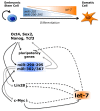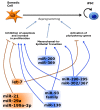Regulatory non-coding RNAs in pluripotent stem cells
- PMID: 23852015
- PMCID: PMC3742248
- DOI: 10.3390/ijms140714346
Regulatory non-coding RNAs in pluripotent stem cells
Abstract
The most part of our genome encodes for RNA transcripts are never translated into proteins. These include families of RNA molecules with a regulatory function, which can be arbitrarily subdivided in short (less than 200 nucleotides) and long non-coding RNAs (ncRNAs). MicroRNAs, which act post-transcriptionally to repress the function of target mRNAs, belong to the first group. Included in the second group are multi-exonic and polyadenylated long ncRNAs (lncRNAs), localized either in the nucleus, where they can associate with chromatin remodeling complexes to regulate transcription, or in the cytoplasm, acting as post-transcriptional regulators. Pluripotent stem cells, such as embryonic stem cells (ESCs) or induced pluripotent stem cells (iPSCs), represent useful systems for modeling normal development and human diseases, as well as promising tools for regenerative medicine. To fully explore their potential, however, a deep understanding of the molecular basis of stemness is crucial. In recent years, increasing evidence of the importance of regulation by ncRNAs in pluripotent cells is accumulating. In this review, we will discuss recent findings pointing to multiple roles played by regulatory ncRNAs in ESC and iPSCs, where they act in concert with signaling pathways, transcriptional regulatory circuitries and epigenetic factors to modulate the balance between pluripotency and differentiation.
Figures







Similar articles
-
Noncoding RNAs in the Regulation of Pluripotency and Reprogramming.Stem Cell Rev Rep. 2018 Feb;14(1):58-70. doi: 10.1007/s12015-017-9782-9. Stem Cell Rev Rep. 2018. PMID: 29143182 Review.
-
The functions of microRNAs and long non-coding RNAs in embryonic and induced pluripotent stem cells.Genomics Proteomics Bioinformatics. 2013 Oct;11(5):275-83. doi: 10.1016/j.gpb.2013.09.004. Epub 2013 Oct 1. Genomics Proteomics Bioinformatics. 2013. PMID: 24096129 Free PMC article. Review.
-
Pivots of pluripotency: the roles of non-coding RNA in regulating embryonic and induced pluripotent stem cells.Biochim Biophys Acta. 2013 Feb;1830(2):2385-94. doi: 10.1016/j.bbagen.2012.10.014. Epub 2012 Oct 24. Biochim Biophys Acta. 2013. PMID: 23104383 Free PMC article. Review.
-
[The effect of microRNAs on the regulatory network of pluripotency in embryonic stem cells].Yi Chuan. 2013 Oct;35(10):1153-66. doi: 10.3724/sp.j.1005.2013.01153. Yi Chuan. 2013. PMID: 24459889 Review. Chinese.
-
MicroRNAs in regulation of pluripotency and somatic cell reprogramming: small molecule with big impact.RNA Biol. 2013 Aug;10(8):1255-61. doi: 10.4161/rna.25828. Epub 2013 Jul 23. RNA Biol. 2013. PMID: 23921205 Free PMC article.
Cited by
-
Differential Expression of Non-Coding RNAs in Stem Cell Development and Therapeutics of Bone Disorders.Cells. 2023 Apr 14;12(8):1159. doi: 10.3390/cells12081159. Cells. 2023. PMID: 37190068 Free PMC article. Review.
-
Highly sensitive and non-disruptive detection of residual undifferentiated cells by measuring miRNAs in culture supernatant.Sci Rep. 2022 Jun 20;12(1):10351. doi: 10.1038/s41598-022-14273-z. Sci Rep. 2022. PMID: 35725891 Free PMC article.
-
High resolution temporal transcriptomics of mouse embryoid body development reveals complex expression dynamics of coding and noncoding loci.Sci Rep. 2017 Jul 27;7(1):6731. doi: 10.1038/s41598-017-06110-5. Sci Rep. 2017. PMID: 28751729 Free PMC article.
-
Infantile Hemangioma Originates From A Dysregulated But Not Fully Transformed Multipotent Stem Cell.Sci Rep. 2016 Oct 27;6:35811. doi: 10.1038/srep35811. Sci Rep. 2016. PMID: 27786256 Free PMC article.
-
Editorial on the Special Issue: Regulation by non-coding RNAs.Int J Mol Sci. 2013 Nov 6;14(11):21960-4. doi: 10.3390/ijms141121960. Int J Mol Sci. 2013. PMID: 24201126 Free PMC article.
References
-
- James D., Levine A.J., Besser D., Hemmati-Brivanlou A. TGFbeta/activin/nodal signaling is necessary for the maintenance of pluripotency in human embryonic stem cells. Development. 2005;132:1273–1282. - PubMed
-
- Vallier L., Alexander M., Pedersen R.A. Activin/Nodal and FGF pathways cooperate to maintain pluripotency of human embryonic stem cells. J. Cell Sci. 2005;118:4495–4509. - PubMed
-
- Ying Q.L., Nichols J., Chambers I., Smith A. BMP induction of Id proteins suppresses differentiation and sustains embryonic stem cell self-renewal in collaboration with STAT3. Cell. 2003;115:281–292. - PubMed
Publication types
MeSH terms
Substances
Grants and funding
LinkOut - more resources
Full Text Sources
Other Literature Sources

